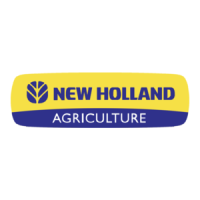SECTION 00 -- GENERAL 5
604.13.542.01 -- 03 -- 2006
STARTING
◊ Do not run the engine in closed areas without
proper ventilation to remove deadly exhaust
fumes.
◊ Do not place head, body, limbs, feet, hands or
fingers, near rotatingfans or belts.Beespecially
alert near pusher fans.
ENGINE
◊ Loosen the radiator cap very slowly, to release
pressurefromthesystem,beforeremovingit.All
coolant level top--ups must be performed with
engine inoperative or at low idle, if warm
◊ Do not run engine when refuelling and use care
if the engine is hot due to the increased possibil-
ity of a fire if fuel is spilled.
◊ Never attempt to check or adjust fan belts when
engine is running. Do not adjust engine fuel
pump when machine is moving.
◊ Never lubricate the machine with engine run-
ning.
ELECTRICAL SYSTEM
◊ Should booster batteries be used, remember to
connect both ends of the booster cables in the
propermanner(+)with (+)and(--)with(--).Avoid
short--circuitsoftheterminals.Followthoroughly
the instructions of this Manual.
Avoid short circuiting the terminals. BATTERY
GAS IS HIGHLY FLAMMABLE. Leave battery
boxopento improveventilationwhenrecharging
batteries. Never check charge by placing metal
objects across the posts. Keep sparks or open
flames away from batteries. Do not smoke near
batterytoguardagainst thepossibilityofcausing
an explosion.
◊ Before any intervention, make sure that there
are no fuel or electrolyte leakages; eliminate
them before proceeding with further work.
◊ When recharging batteries in closed ambient,
make sure that thereisappropriateventilationto
prevent possible accidental explosions due to
the accumulation of gases generated during the
recharge.
◊ Beforeany intervention,makesurethat themain
switch is OFF.
HYDRAULIC SYSTEM
◊ Fluidescapingunder pressure froma verysmall
hole can be almost invisible and can have suf fi-
cient force to penetrate the skin. Use a piece of
cardboardor woodto searchfor suspectedpres-
sure leaks. DO NOT USE HANDS. If injured by
escaping fluid, see a doctor at once. Serious
infection or reaction can develop if proper medi-
cal treatment is not administered immediately.
◊ In case pressures must be measured, use
instruments of adequate capacity. Always follow
the recommended procedures.
WHEELS AND TYRES
◊ Makesurethat theinflation pressureof thetyres
is according to the specifications issued by the
Manufacturer and check it periodically.
◊ Should the pressure be changed, stand on the
side of the tyre at a safe distance.
◊ Pressure check operations must be performed
with unloaded machine and cold tyres. Never
use reconditioned tyre rims, since eventual
weldings, heat--treatments or repairs not per-
formed correctly can weaken the wheel, thus
causing subsequent damages or dangers.
◊ Do not perform torch cutting or welding oper-
ations on rims with inflated tyres installed.
◊ Before operatingon tyres, blockall wheels, front
and rear. After jacking the machine, block it with
stands according to current safety rules and
regulations.
◊ Before removing objects from the tyre tread,
deflate it.
◊ Never inflate tyres with flammable gas;
explosions and serious bodily injuries may
result.
REMOVALS AND INSTALLATIONS
◊ Liftandhandle allheavypartswithliftingdevices
of adequate capacity. Make sue that the parts
are attached to lifting devices are properly
slinged. Use the liftingeyesprovided. Bewareof
persons in the vicinity.
◊ Handle all parts carefully. Keep hands and
fingers away from structures, gears or moving
parts. Use and wear always the appropriate
protections, such s goggles, gloves and safety
shoes.
◊ Prevent chains and cables from kinking. To
handle them, always use heavy gloves.

